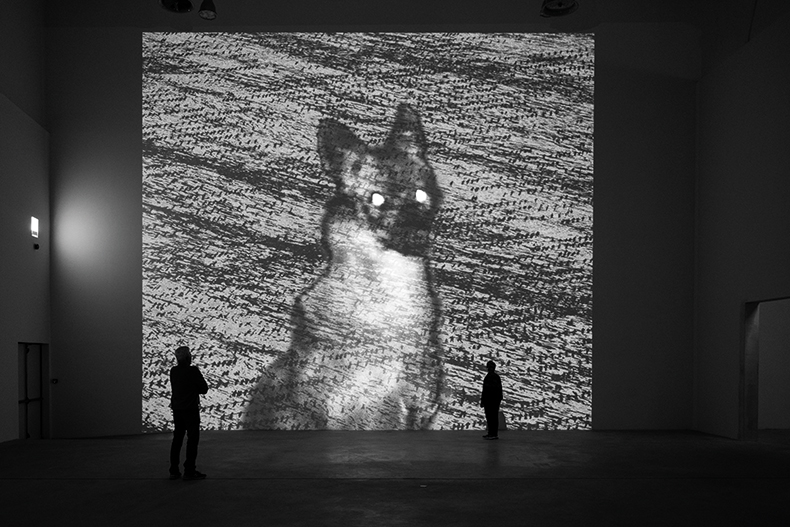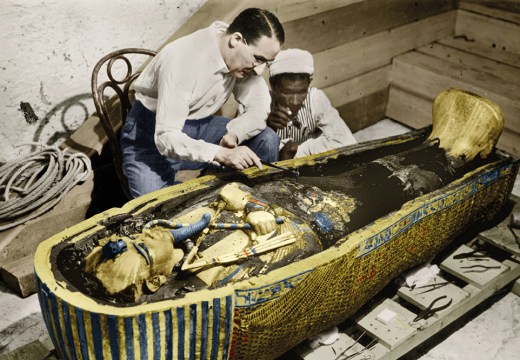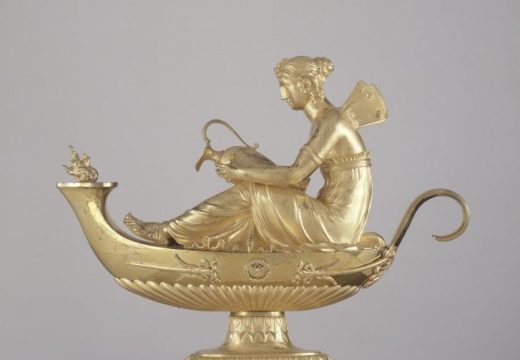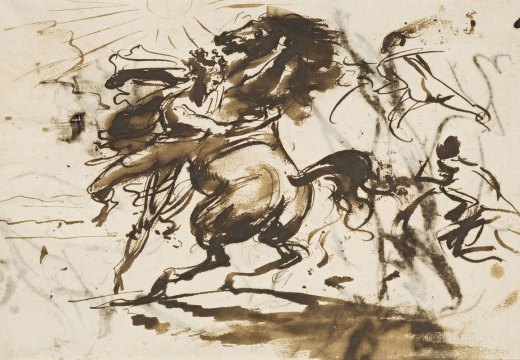From the February 2023 issue of Apollo. Preview and subscribe here.
It is difficult to avoid ancient Egypt in Turin, a city founded (according to legend) by an exiled Egyptian who named it after the sacred Apis bull, or Latin taurus. An outsized fibreglass sphinx, based on a statue in the Museo Egizio, surveys the airport road from a roundabout and the museum itself is one of Turin’s top attractions. Housed in a baroque palazzo in the city centre, it sits square and stolid within the gridded street plan that inspired Giorgio de Chirico to describe Turin as ‘the most profound, most enigmatic, and most disquieting city, not in Italy but in the world’.
This winter in Turin, Egyptian myths have sounded a quiet, and disquieting, note in two exhibitions of contemporary art. At the Fondazione Merz and Museo Egizio, the Israeli artist Michal Rovner and the Amsterdam-based Egyptian artist Sara Sallam use ancient religious motifs to reflect on modern anxieties around death and the act of displacement, whether through war and mass migration (Rovner) or the epistemic violence committed by archaeology in colonised lands (Sallam).
Based in a 1930s building that was the energy plant of the former Lancia auto factory, in the Borgo San Paolo neighbourhood, the Fondazione Merz is off the tourist track but a fixture in Turin’s contemporary art scene. It houses the archive of Arte Povera artist Mario Merz, a reference library and a versatile exhibition and event space; the foundation also sponsors a biennial prize for artists and musicians.

Installation view of Alert (2022) by Michal Rovner (b. 1957) at the Fondazione Merz, Turin. Photo: Andrea Guermanil courtesy Fondazione Merz; © the artist
For her site-specific installation Alert, Rovner has turned two ground-floor galleries into a space she characterises as a temple, immersing visitors in darkness illuminated only by large-scale video projections. The projections – three still, one moving – are sequences Rovner filmed at night with infrared equipment normally used for hunting or surveillance. Their subject is always the same: golden jackals, the desert animals associated with the Egyptian god Anubis, who guided the dead to the underworld. Ancient art often coloured jackals black, a reference to the resin-rich substances that coated sacred images, including mummied bodies. A ‘master of secrets’ in his wisdom, Anubis exuded calm, yet Rovner’s patient filming – begun in response to the refugee crisis of 2015 – reveals anxiety beneath the wild animal’s state of constant watchfulness. Its eyes turned piercing white by the infrared technology, one jackal in Alert appears against moving rows of human figures, a feature Rovner has used in other work. Editing reduces individuals to uniform black marks, like strokes of a pen or lines of incised script. Only movement – bowing, striding, waving – reveals their humanity. Maybe, the artist has said in an interview, they are signalling for attention or to trigger our conscience. In an adjacent gallery, however, the crouched and apprehensive posture of another jackal draws into question whether these familiars of Anubis can offer the uprooted any divine guidance or protection.
Back in the centre of Turin, the Museo Egizio has chosen to tuck Sara Sallam’s exhibition, ‘Through Tutankhamun’s Eyes’, into a corner of the elegant brick-built palace it shares with the Accademia delle Scienze. The show opened in time for the centenary of the discovery of the tomb in November 2022, with an introductory panel pointing to the Museo Egizio’s upcoming bicentenary in 2024 as well. Sallam works with photography, video, printed books and spoken words to link her own experience as an immigrant in Europe with the displacement of Egyptian antiquities, the presence of which in museums and urban spaces reverberates with the artist’s own sense of not-belonging and, she imagines, a shared longing for home. Collages insert heroic paintings of Napoleon’s Egyptian campaign into Parisian streets named after his short-lived victories, or reunite the estranged Place de la Concorde obelisk with its twin in Luxor. The selection of works excludes depictions of modern Egyptians (apart from the painted stereotypes of Antoine-Jean Gros), but elsewhere in her work, Sallam has used family photographs to place Egyptians into the history colonialism tried to deny them.
A new work on display is a short film titled I prayed for the resin not to melt (2022). It opens with a photograph from 1925, showing Tutankhamun’s head in profile after the unwrapping of his embalmed corpse. Soft white cloth cushions it and conceals his decapitation at the hands of the anatomists. A first-person text, voiced by Sallam, passes across the black screen, relaying Tutankhamun’s doubt, dread and resignation as the unnamed archaeologist (addressed as ‘you’) breaches first his tomb, then his coffin, then his body. Punctuating the narrative are whis-pered phrases from the prayer that goldsmiths engraved on the back of the now-famous mask, to declare and defend the king’s divinity. My right eye is the sun-god’s evening boat. My left eye is his morning boat. My eyebrows are those of the gods. My forehead is that of the jackal-headed god of the dead. Anubis, again.
Sallam’s video adds gold foil to the photograph and replaces the textile wrappings that once covered the stripped face. But what is done cannot be undone outside of art, and ancient prayers fall on deaf ears, or none at all. Few visitors seem to have followed the detour needed to reach the unticketed space, even over the festive period when admission to this popular museum sold out by midday. According to its subtitle, the show offers ‘alternative perspectives on Egyptology’, but the alternative by definition does not impinge on the authoritative – and artists from the global south are not shortcuts to a sanitised decolonial agenda. In different ways, and very different venues, Rovner and Sallam present ancient Egyptian myths as relevant to our contemporary condition, not because they offer comfort but because they draw our attention to its absence. De Chirico was right. Turin remains a city of disquiet.
From the February 2023 issue of Apollo. Preview and subscribe here.
Unlimited access from just $16 every 3 months
Subscribe to get unlimited and exclusive access to the top art stories, interviews and exhibition reviews.














![Masterpiece [Re]discovery 2022. Photo: Ben Fisher Photography, courtesy of Masterpiece London](http://www.apollo-magazine.com/wp-content/uploads/2022/07/MPL2022_4263.jpg)
It’s time for the government of London to return to its rightful home